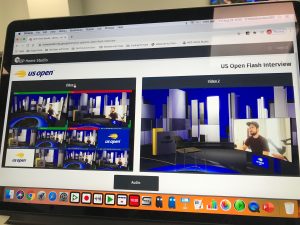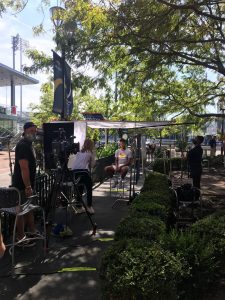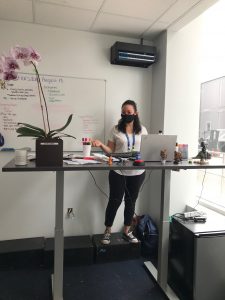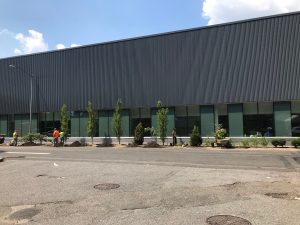US Open Returns: An Inside Look at the Massive Effort To Make the Tourney a Reality
More-remote production, new workflows, COVID protocols help put people first
Story Highlights
The 2020 US Open has plenty of technical enhancements that have made a difference to viewers and new workflows that have enabled more-remote production and social distancing in response to the COVID-19 pandemic. But it’s pretty clear what is most important at the year event: the people.
The US Open production employs hundreds of freelancers from across the tri-state area, and it isn’t lost on USTA Managing Director, Broadcast, Patti Fallick, how important the past few weeks have been for all involved.
“All the freelancers were constantly sending texts asking if this was really going to happen,” she says. “Up until we showed up onsite, no one really knew what was going to happen. But people were anxious because they hadn’t worked, so it felt really good that we were hiring, because people have been struggling.”
This year’s effort is the result of months of planning, contingency planning, and taking some risks with new technologies. Weekly calls with vendors like Hawk-Eye, SMT, ATP Media, WTA Media, NEP, ESPN, the USTA, and “any vendor that touched anything” were the order of the day leading up to the tournament.
“We went through every issue and every concern to make sure everything was integrated,” says Fallick. “We wanted to make sure everybody understood what everybody was trying to accomplish.”
The goal was to pull off the first tennis major to be played in the age of COVID-19 and to hold it in New York City, arguably ground zero of the pandemic here in the U.S. No fans, no international rightsholders onsite, no media were part of the solution. Plenty of strict protocols to make sure everything is as safe as possible was the other part.
The process began with an appraisal of the number of onsite production personnel and determine who truly needed to be at the Billie Jean King Tennis Center. The result is that many staffers are working from home (the loggers are located in the cafeteria in the USTA’s office in White Plains, NY) with improved internet connections so that they could have quick access to files and content-creation tools.
Twelve editors, for example, were provided virtual EVS IPDirector content managers by Veritone and THUMBWAR so that they could access content sent from the Billie Jean King Tennis Center via a 10-Gbps circuit to NEP Media Bank’s facility in Washington, DC.
“We’ve proven that our digital teams, social teams, and editors can all work offsite,” she says. “NEP Media Bank, Veritone and THUMBWAR put together a system so we can move content around seamlessly to all of the people that are working remotely. There have been zero issues; we haven’t had one complaint. And I credit a lot of people spending a lot of hours figuring the system out.”
The Veritone system also allows rightsholders around the world to get the content they need.
“The Digital Media Hub is the lifeblood of our operation because it has all the content on it that we share with partners,” says Fallick. “We knew everyone was going to be remoting in and it was going to tax their ESPN graphics personnel, who typically would be located inside the ESPN production unit but were moved into the international broadcast building.
“We’re lucky that the new broadcast building has a lot of space,” she continues, “and it was configured with enough flexibility that it could be easily adapted.”
There are only two sets onsite, both for ESPN, and both needed to expand.
“Filmwerks is a great vendor, and we called them at the last minute to see if they could expand the ESPN set on the South Plaza,” says Fallick. “Not only did they do that, but they also enlarged the set on the practice courts for ESPN.”
With respect to COVID-19 safety protocols, there are two tiers of production staffers: those who are in the compound and stadium and those who are in contact with the players and other personnel.
“We originally thought the compound would be split between those who needed to go into Ashe Stadium and those who didn’t,” says Fallick, “but, when we started to think about how everybody was going to be interacting, we decided to make everyone Tier 2.”
The most disappointed people with respect to the tiers have been some of the documentary filmmakers. A number of documentaries are being shot this year, and a number of producers reached out thinking they would be able to get access to the grounds.
“I had to tell them no and that we would shoot it for you,” says Fallick. “Tier 1 production personnel shooting the documentaries stay in the player hotel and are in the player bubble along with the talent because they do get in contact, but not close contact, with the players.”
The Virtual Flash

The USTA has four ENG crews interviewing players around the US Open grounds.
One of the issues every sports league has grappled with this year is how to make it easy for athletes to be interviewed without violating social-distancing requirements. At the center of those challenges is the Flash position, which at a tennis major can be as complicated as it is at the Olympics. Typically, rightsholders would request an interview the day before and then, depending on who wins, would get on the court and interview the player. That was not happening this year, and the first thought was that the USTA would do the interviews, but that plan would add the complexity of getting the interviews to the rightsholder.
“We couldn’t figure out how to do those interviews as they would need to be done for every match,” says Fallick. “We came up with the idea of a virtual studio, and, at first, people looked at me like I was crazy.”
The first step was to find a location on the grounds that was suitable, she notes, and an old Studio in Ashe Stadium that served as a player recovery area last year was turned back into a studio. It needed to be outfitted with air-filtration devices, and NEP and Creative Technologies came in with three robotic cameras, an IFB, a green-screen studio that can be switched from one rightsholder to the next in about 30 seconds.
“It is getting a ton of usage,” says Fallick, “and the players like it because they’re in the Flash studio with no one else. They sit down in the chair and put on the headphones, and the headphones are thrown away when they are done.”
The use of the virtual Flash studio is the biggest addition (other than a permanent broadcast building under construction), allowing rightsholders to interview athletes after their matches. In the green-screen studio, the player hooks up the IFB (Eurosport is taking virtual to a new level with its Cube), and the three robotic cameras shoot the interview.
The press room also needed a new approach, and NEP and Creative Technology rolled in a giant LED screen and proprietary NEP technology to allow players to sit in front of a screen where they can see the people asking questions.
“Both the Flash studio and press room are all-robotic, and everything is sanitized between players,” Fallick points out. “We were solving not only the technology but also the COVID-19 restrictions at the same time.”
Also new to the coverage this year is the addition of a drone.
“We had drone shots at sunrise and sunset over the grounds,” says Fallick, “and it just added a whole different dimension. I’ve had a lot of toys this year, and I hope to get some of them again next year.”
Given that there are no international rightsholders onsite, the responsibilities falling to the USTA represent those that HBS oversees at a World Cup or OBS handles at an Olympics. The USTA’s four ENG crews capture video from around the grounds for the rightsholders, who access thousands of clips and hours of content remotely.
“We want to make sure they have all the resources they need to make their shows the best that they can,” says Fallick. “I think we’re really fortunate in that our vendors, even though they compete outside of this venue, work really well together here. They cooperate, they become friends, and they’re all in this together to make the US Open the best event that it can be. And that’s really cool.”
The good news is, Fallick does expect the international rightsholders to want to be back onsite. And steps that the USTA has taken this year will make it more cost-effective for them to do so, starting with a broadcast building under construction that is pre-cabled and also has a TOC that is 4K-capable. The 20,000-sq.-ft., two-story building has proved to be a major asset this year, offering plenty of space for socially distancing the production teams. It will be 100% ready for action next year.
“The new broadcast building is 80% done,” Fallick says. “NEP laid in a ton of permanent fiber, and we have a permanent CenturyLink circuit in the building. That is a game-changer: we can set up a week or two later than previously because we don’t have to run fiber and infrastructure. When we leave, we can leave all of the consoles. And everything is just plug-and-play.”



